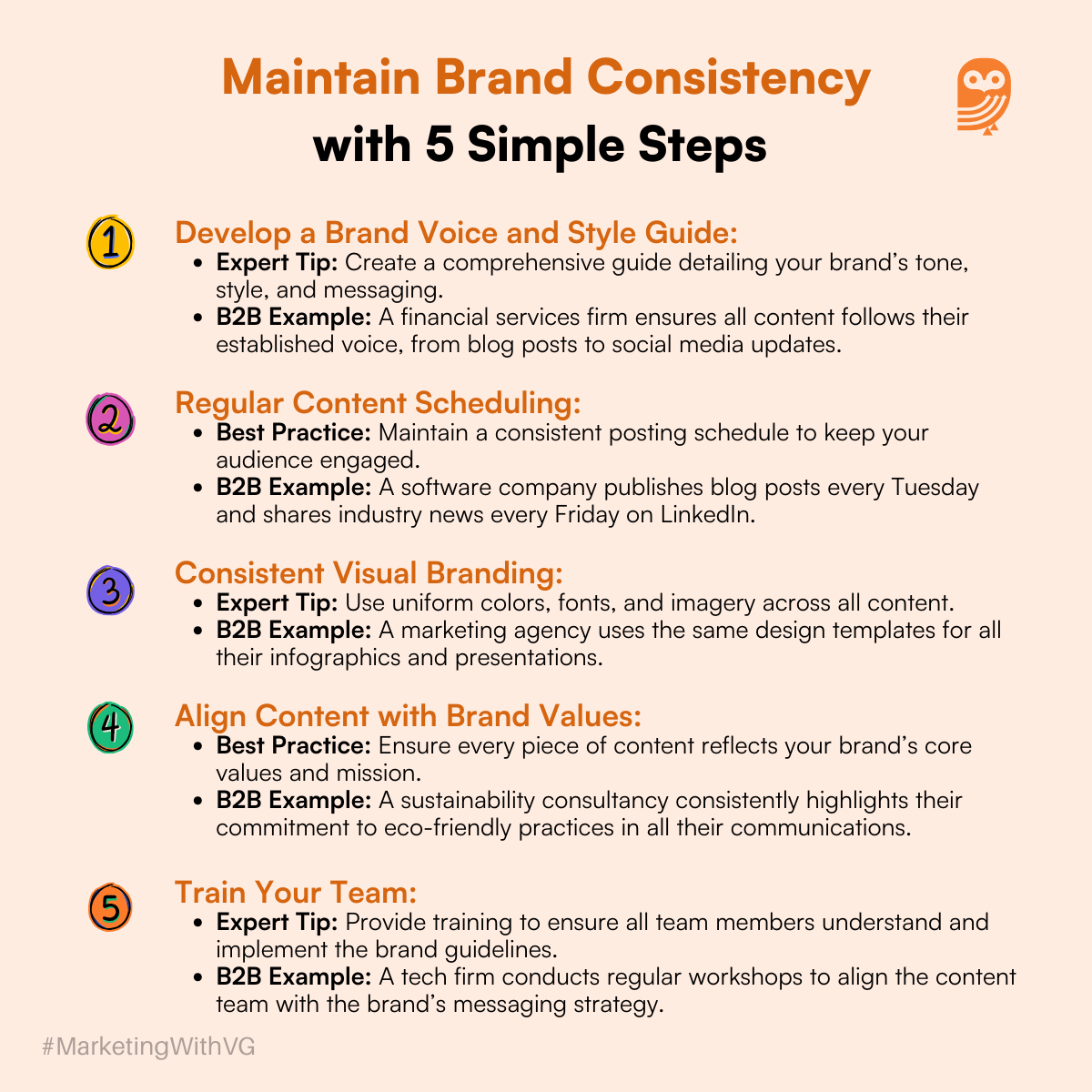Vivek Goel
June 27, 2025
Maintaining Consistency in Content in 5 Simple Steps: Building Brand Trust and Recognition

Introduction
In the ever-evolving digital landscape and content marketing, maintaining consistency in content is essential for building a strong brand identity, fostering trust with your audience, and ensuring your messaging is clear and cohesive across all channels. For B2B businesses, where trust and credibility are paramount, consistent content can significantly impact your brand’s success. This blog will explore the importance of consistency in tone, style, and delivery and provide actionable tips to help you maintain it effectively.
Why Consistency Matters
Building Brand Identity
Consistency in content helps establish and reinforce your brand identity. It allows your audience to recognize your brand quickly and associate it with specific values and messages. A strong, consistent brand identity differentiates you from competitors and makes your business more memorable.
Example: Salesforce consistently uses a friendly, approachable tone in all its communications, reinforcing its brand identity as a customer-centric, innovative company.
Fostering Trust and Credibility
When your audience sees consistent messaging across all platforms, it builds trust. They know what to expect from your brand, which fosters a sense of reliability and credibility. Inconsistent messaging, on the other hand, can confuse your audience and undermine trust.
Example: IBM maintains a professional and authoritative tone across its content, positioning itself as a leader in technology and innovation. This consistency reinforces trust among its B2B clients.
Enhancing Customer Experience
Consistency in content also enhances the customer experience. When your audience encounters a seamless, cohesive brand message, it creates a more enjoyable and reassuring experience. This positive experience can lead to increased loyalty and engagement.
Example: HubSpot provides consistent, high-quality educational content across its blog, social media, and email campaigns. This cohesive approach ensures a positive and informative experience for their audience.
Top 5 Best Practices for Maintaining Consistency in Content

1. Develop a Brand Voice and Style Guide
A brand voice and style guide is a comprehensive document that outlines your brand’s tone, style, and messaging guidelines. It ensures that everyone in your organization is on the same page and adheres to the same standards when creating content.
What to Include:
- Brand Voice: Define the personality of your brand. Is it professional, casual, friendly, or authoritative?
- Tone: Specify how the brand voice is expressed in different contexts. For example, a more formal tone for whitepapers and a conversational tone for social media.
- Style Rules: Include guidelines on grammar, punctuation, and writing style.
- Visual Elements: Outline the use of logos, colors, fonts, and imagery.
Example: Mailchimp’s Voice and Tone Guide provides detailed instructions on how to communicate in various scenarios, ensuring a consistent brand voice across all content.
2. Regular Content Scheduling
Consistency in your posting schedule is crucial for keeping your audience engaged and building a reliable presence. Establish a content calendar to plan and organize your content across different platforms.
Tips:
- Plan Ahead: Create a monthly or quarterly content calendar that includes blog posts, social media updates, email newsletters, and other content.
- Be Consistent: Stick to your schedule. For example, post new blog articles every Tuesday and share industry news on LinkedIn every Friday.
- Adjust as Needed: Regularly review your content calendar and make adjustments based on performance data and audience feedback.
Example: Moz consistently publishes their Whiteboard Friday video series, providing valuable SEO insights every week. This regular schedule has built a loyal following.
3. Consistent Visual Branding
Visual consistency is just as important as verbal consistency. Ensure that your visual elements, such as colors, fonts, and imagery, are uniform across all content.
Tips:
- Use Templates: Design templates for different content types, such as blog posts, social media graphics, and presentations, to maintain a consistent look and feel.
- Brand Colors and Fonts: Stick to your brand’s color palette and typography in all visual content.
- Logo Usage: Follow guidelines on logo placement and usage to ensure consistency.
Example: Slack uses a consistent color palette and design style in all their marketing materials, from their website to their social media posts, creating a cohesive visual identity.
4. Align Content with Brand Values
Every piece of content should reflect your brand’s core values and mission. This alignment ensures that your messaging is not only consistent but also authentic and meaningful.
Tips:
- Core Values: Clearly define your brand’s core values and ensure they are reflected in your content.
- Mission Statement: Regularly reference your mission statement to guide content creation.
- Content Audit: Conduct regular audits to ensure all content aligns with your brand values.
Example: Patagonia consistently reflects its commitment to environmental sustainability in all its content, from product descriptions to social media posts, reinforcing its brand values.
5. Train Your Team
Ensure that everyone involved in content creation understands and adheres to your brand guidelines. Regular training sessions can help maintain consistency and improve the overall quality of your content.
Tips:
- Workshops and Seminars: Conduct regular training sessions to educate your team on the brand guidelines and the importance of consistency.
- Feedback Mechanism: Implement a system for reviewing and providing feedback on content to ensure it aligns with brand standards.
- Documentation: Keep your brand voice and style guide easily accessible for all team members.
Example: Microsoft conducts regular workshops to align the content team with the brand’s messaging strategy, ensuring consistency across all communications.
Conclusion
Maintaining consistency in content is crucial for building a strong brand identity, fostering trust, and enhancing the customer experience. By developing a comprehensive brand voice and style guide, scheduling content regularly, ensuring visual consistency, aligning content with brand values, and training your team, you can create a cohesive and recognizable brand presence.
Consistency in content builds a recognizable and trustworthy brand, making your communications more effective and memorable. Ready to maintain consistency in your content? Implement these best practices and watch your brand grow in credibility and recognition.
Top Frequently Asked Questions (FAQs) on Consistency in Content
To maintain consistency with multiple content creators, develop a detailed brand voice and style guide. Provide comprehensive training sessions for all team members to ensure everyone understands and adheres to the guidelines. Implement a feedback and review system to monitor and ensure that all content aligns with your brand standards before it is published.
Measure the effectiveness of your content consistency through key performance indicators (KPIs) such as brand recognition, audience engagement, and conversion rates. Use tools like Google Analytics, social media insights, and feedback surveys to track these metrics. Regularly review these KPIs to assess how consistency in content is impacting your brand’s overall performance.
Common challenges include managing multiple content creators, adapting content for different platforms, and maintaining quality over time. Overcome these by centralizing your content creation process with a content management system (CMS), providing regular training, and conducting frequent content audits. Use templates and automation tools to streamline the process and ensure uniformity.
To ensure visual consistency, create a brand style guide that includes guidelines for color schemes, fonts, imagery, and logo usage. Use design templates for different content types such as blog posts, social media graphics, and presentations. Regularly update and share the style guide with your team to ensure everyone is aligned with the visual branding standards.
Review and update your brand voice and style guide at least once a year, or whenever there is a significant change in your brand strategy, target audience, or market conditions. Regular reviews ensure that the guide remains relevant and aligned with your brand’s evolving identity and goals. Engage your content team in the review process to gather insights and suggestions for improvements.
